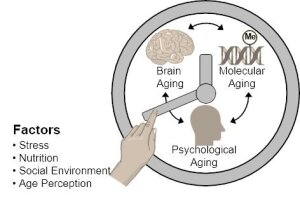
IMPULS Logo
Graphic: IMPULS Research ConsortiumIMPULS – Identification and manipulation of the physiological and psychological clocks of lifespan
“Every man desires to live long; but no man would be old”. This sentence by Jonathan Swift reflects our attitude towards aging. Even if we have more and more lifetime available, we view aging sceptically, even fearfully. One possible reason is that our understanding of the biology underlying the aging process is still sparse, so that our society forces age into a straitjacket of years with rather arbitrary classifications of young and old. However, aging proceeds very differently between individuals, depending on numerous endogenous and exogenous factors.
In the future, understanding how and why we age could change our society's outdated view on aging. The experiments and studies in IMPULS will be complemented by addressing ethical questions arising with the precise prediction of biological age. In addition to the social relevance of our project, we see great potential for health promotion in old age. Our findings will not only allow us to detect pathological aging processes at an early stage but also identify intervention options. Ultimately, we will contribute to increasing the quality of life of the elderly and to the prevention of age-related diseases. In cooperation with renowned national and international researchers on aging, the project leaders of IMPULS will create innovative solutions for the central questions of an aging society.
The three dimensions of aging (brain aging, molecular aging, psychological aging) are influenced by external factors, e.g., stress, nutrition, social environment.
Image: Holger BierhoffMajor focuses of IMPULS
- The interplay between established and newly identified clocks of life span
- Effects of physiological factors on aging
- Social and psychological impacts on biological aging
- Ethical considerations on the measurement of biological age






